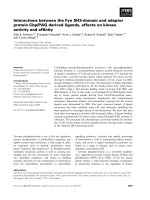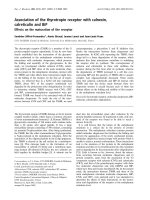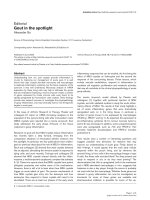Báo cáo y học: "Shadows on the wall" ppsx
Bạn đang xem bản rút gọn của tài liệu. Xem và tải ngay bản đầy đủ của tài liệu tại đây (228.44 KB, 3 trang )
‘In order to thrive,’ writes Boston College Director of
American Studies Carlo Rotella in a splendid essay on
Magic Slim and Buddy Guy, the last of the great 1950s
Chicago blues musicians, in e Boston Globe (13
September 2010), ‘every genre or style needs both
visionary innovators and orthodox practitioners. Without
the former, it becomes hidebound. Without the latter, it
drifts and loses its center.’ But what happens when
orthodoxy becomes dogma? What is the fate of
innovators when they pose a threat, not to the accepted
view, but to the accepted truth?
e best discussion of that situation I have ever read is
over 2000 years old. It’s Plato’s Allegory of the Cave, and
it’s one of my favorite passages in classical literature.
e allegory is presented as an imaginary dialogue
between Socrates and Plato’s brother Glaucon, but it’s
really Plato speaking. Imagine, he says, a group of people
who are born and live all their lives in a cave. ey are
forced to sit in chairs facing the back wall of the cave,
restrained so that they cannot look anywhere else.
Behind them, at the mouth of the cave, is a large fire, and
between them and the fire is a walkway along which
people carrying things, including replicas of animals,
pass continuously. All the people of the cave can ever see
are the shadows cast on the wall in front of them by
those passing behind. All they can hear are the echoes in
the cave produced by the movements they never see.
Would they not, Plato asks, come to believe that those
shadows and echoes are reality? Would they not assume
that the entire world consists of the cave and the
shadows on the wall? Wouldn’t they praise as clever
whoever could best guess which shadow would come
next as someone who understood the nature of the
world? And wouldn’t the whole of their society come to
depend on the shadows on the wall?
It’s a powerful image, but Plato takes it further. Now let
us suppose, he says, that one of the people of the cave is
freed from his chair and allowed to face the outside.
Would he not first be blinded by the fire? And then, as his
eyes adapted and he saw the people passing by on the
walkway, would he not distrust the things he saw,
believing that his eyes deceived him, because what they
showed him contradicted what he knew reality had to be?
en Plato goes still one step more. Let us now imagine
that our freed cave dweller eventually acclimates to the
world outside the cave, and recognizes that as reality.
‘Wouldn’t he then remember his first home, what passed
for wisdom there, and his fellow prisoners, and consider
himself happy and them pitiable? And wouldn’t he
disdain whatever honors, praises, and prizes were
awarded there to the ones who guessed best which
shadows followed which? Moreover, were he to return
there, and try to explain to them that their reality was all
an illusion, wouldn’t it be said of him that he went up
whole and came back with his eyes corrupted? And if the
people of the cave were somehow able to get their hands
on him, wouldn’t they try to kill him?’
I’ve been thinking about this allegory a lot lately
because there are many things about our current situa-
tion that cause me to wonder whether a lot of people
haven’t been looking at shadows on the wall and mis-
taking them for reality. It seems to be particularly true in
American politics and economics. For example, despite
mountains of evidence to the contrary, many Americans
believe that Barack Obama is a Muslim (he isn’t) and that
the Obama Administration was responsible for the
financial crisis (it wasn’t; it hadn’t even been elected yet) -
and the number who believe these things is actually
increas ing. And before you put this down to closet bigotry
(which some of it may be), let me remind you that over
75% of my fellow countrymen believe in angels and less
than 50% believe in evolution, even though the first do not
represent reality and the second does. Perhaps the greatest
success of the right wing in the United States is having
convinced most middle- and lower-class Americans that
their own happiness and material well-being depend on
unregulated capitalism, even though all examples of that
unfettered beast known to date have been characterized
chiefly by its feasting on those same Americans.
Declining standards of education - and the creeping
hegemony of the religious right over local schools - is one
reason for this, but a bigger reason is that it is very easy
nowadays to spend your entire life, figuratively speaking,
looking at the same comforting set of shadows, without
© 2010 BioMed Central Ltd
Shadows on the wall
Gregory A Petsko*
C O M M E N T
*Correspondence:
Rosenstiel Basic Medical Sciences Research Center, Brandeis University, Waltham,
MA 02454-9110, USA
Petsko Genome Biology 2010, 11:136
/>© 2010 BioMed Central Ltd
ever having to turn and face the world outside the cave.
Ideologically driven cable ‘news’ channels, which claim to
be ‘fair and balanced’ but are actually neither, make it
possible for people to derive all their information from a
source that never challenges their view of the world, and
the same is true of the plethora of biased internet
‘information’ sites. Journalism has been replaced by
opinion, and objectivity in media is threatening to go the
way of the dodo, because people become angry when
their worldview is challenged, and advertisers, who call
most of the shots these days, don’t like angry people.
And woe betide the individual who tries to convince
his or her fellow citizens that what they have been
looking at are nothing but shadows on the wall. ey
aren’t always killed - Plato was exaggerating for effect,
though it has happened, especially in countries where
there is an orthodox religion and/or a totalitarian regime
- but they are certainly ridiculed, marginalized, scorned,
and often abused.
We’ve all seen that scenario, in many aspects of life.
When innovation is viewed as heresy, those who have
much invested in the status quo may become not just
master journeymen, but witch-hunters. Nothing is more
stifling to progress, not only in the arts, education and
politics, but in science. Especially in science.
Scientific progress depends on constant challenges to
our notion of what reality is. e moment we believe
something is completely understood, we lose the drive to
explore. At the turn of the century, many physicists
believed that classical physics had provided a complete
description of the world; all that was necessary to do
henceforth was to measure things to ever increasing
precision. e mavericks who challenged that assumption
eventually discovered quantum mechanics, but until
people became convinced that the new physics gave a
more accurate description of reality these pioneers were
ignored or reviled. is is why Max Planck, in a famous
remark aimed at his own detractors, said, ‘Truth never
triumphs, but its opponents eventually die.’
Of course, many new ideas really are wrong, but it’s
when we start to assume that any new idea must be
wrong because it doesn’t fit into what we are certain is
right that we become obstacles to progress. Skepticism is
a good thing, and extraordinary claims really do require
extraordinary evidence, but the most exciting time in
science is when paradigms fall, shibboleths become signs
of stodginess, and everything is up for grabs.
Looking at biology today, I can see a number of
paradigms that seem ripe for toppling, but that will
probably evoke a lot of resistance when challenged.
Here are a few:
e idea that a number of highly expressed proteins are
‘natively unfolded’ or ‘intrinsically disordered’ in the cell.
is is most often said about alpha-synuclein, the
membrane-associated, Parkinson’s disease-related protein
that makes up almost 1% of the protein content of
neurons. When isolated, often by a boiling step, synuclein
behaves as a random coil until incubated with lipids, at
which point it acquires a fair amount of helical structure.
But, really, how likely is it that it isn’t at least partially
folded in vivo? Cells have elaborate machinery to fold
proteins that have trouble folding, and equally elaborate
machinery to degrade those that don’t fold. Do you really
believe that 1% of the protein content of a neuron is made
up of something with all the structural order of a plate of
spaghetti? I have grave doubts. at some portions of
many proteins are disordered I am sure of, but that an
abundant cellular protein should be unfolded most of the
time strains credulity. Part of the problem, I suspect, is
that the term ‘natively unfolded’ is ambiguous. If it means
unfolded in the cell, as I said, I’m dubious. If it means that
it would be unfolded unless it came into contact with
lipids, well, I can accept that, but isn’t that the case with
any integral membrane protein, for example, yet no one
would ever call them ‘intrinsically disordered’. But heaven
help anyone who challenges the idea that synuclein is
unfolded most of the time. is paradigm has completely
taken over the Parkinson’s research community, and it
will die hard.
e notion that prokaryotic cells are much less
organized than eukaryotic cells. is one may actually be
on the way out, I’m glad to say, but all the biology and
biochemistry textbooks I’m aware of still imply it, if they
don’t say so directly. I suspect many scientists who work
on eukaryotic systems still hold to it, if only
subconsciously. e more we learn about prokaryotes,
though, the more highly organized and complex their
interiors seem to be. e view of bacteria as bags of
enzymes and nucleic acids while mammalian cells are
models of organizational complexity and sophistication is
probably about as much a description of reality as the
ancient notion that the earth was the back of a giant
turtle. Bacteria may even turn out to be more sophis-
ticated, because they have had make do with a smaller
cell volume and fewer genes.
In genome biology, the idea that all projects aimed at
gathering massive amounts of data are equally worth-
while. Most scientists probably wouldn’t subscribe to
this, at least not publicly, but unfortunately, many science
administrators do. Data-mining has become so linked
with genomics that it consumes most of the funding,
even when, as in the case of projects like struc tural
genomics and genome-wide association studies, the
results have proven to be worth far less than their
originators’ hype proclaimed they would be. I don’t mind
trying such things out to see if they might be useful, but
we seem utterly unable to pull the plug on them, or even
phase them out gradually, when it becomes clear that
Petsko Genome Biology 2010, 11:136
/>Page 2 of 3
they are not. e human genome sequencing project was
a great achievement, and has already repaid its cost many
times over in knowledge and in the spawning of other
great science. Neither of the projects I just mentioned
have done so, and I think it’s a pretty safe bet that they
never will. We need a balance in the types of science we
support and value, but balance is something that seems
in short supply these days.
e belief that to model a system is to understand it.
Systems biology, which started out as a nice modern
version of physiology, has almost been hijacked by this
paradigm. I’ve got nothing against models, but I do
question the blind notion that they equate to under-
standing. Sometimes they do, but far more often they
represent, not a more sophisticated view of a complex
system, but an oversimplified one (albeit an over-
simplified view that, one hopes, can make quite useful
predictions). e tacit assumption that those who don’t
model are archaic reductionists is almost insulting to
geneticists and physiologists, who have long under stood
the importance of considering pathways and processes,
interconnected and parallel, in interpreting their experi-
mental data. e other day I heard a compu tational
biologist describe one of his simulations as ‘an experi-
ment’. I know what he meant, and I suppose it’s okay to
use that term for any procedure undertaken to make a
discovery or test a hypothesis, but it still made me cringe.
e best modelers have one foot firmly planted on
measured data from real organisms or molecules (and, to be
fair, I think the best experimentalists these days maybe
should at least have one toe dabbling in the sea of modeling).
Each of these paradigms is characterized by two things:
a sense that it represents the only right view of the world
and a coterie of staunch defenders whose reputations and
funding depend on acceptance of that view. I’ve seen
people who challenge one of them dismissed, not with a
careful critique of their evidence for challenging it, but
with the statement that ‘everybody knows this is the way
it is, so you must be wrong.’ It’s been said that there are
three stages in the development of an idea: (1) that’s
ridiculous, we all know it’s not that way; (2) there may be
something to what you say, but it isn’t important; and (3)
oh, we all knew that all along. What looks like a true
perspective may be nothing more than a rut based on
untested assumptions, but try telling that to those whose
livelihood revolves around it.
We can all fall into this trap so easily. If we’re not
careful, we can mistake our assumptions about reality for
reality itself. We can become comfortable, unquestioning,
robotic - even dogmatic. We can forget that science only
thrives when everything is examined, everything is
questioned, and assumptions are not confused with facts.
Mavericks are discomforting, often annoying, but
without them we risk spending our scientific lives in a
cave, never realizing that the things we believe in are
merely shadows on the wall.
Published: 23 September 2010
doi:10.1186/gb-2010-11-9-136
Cite this article as: Petsko GA: Shadows on the wall. Genome Biology 2010,
11:136.
Petsko Genome Biology 2010, 11:136
/>Page 3 of 3









